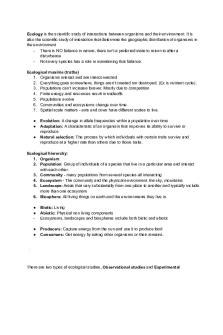Lecture 1 PDF

| Title | Lecture 1 |
|---|---|
| Author | Travis Scott |
| Course | Ecology |
| Institution | The University of Western Ontario |
| Pages | 3 |
| File Size | 135 KB |
| File Type | |
| Total Downloads | 5 |
| Total Views | 158 |
Summary
Ecology Lecture for Summer Term....
Description
Ecology is the scientific study of interactions between organisms and their environment. It is also the scientific study of interaction that determine the geographic distribution of organisms in the environment - There is NO balance in nature, there isn’t a preferred state to return to after a disturbance - Not every species has a role in maintaining that balance. Ecological maxims (truths) 1. Organisms interact and are interconnected 2. Everything goes somewhere, things aren’t created nor destroyed. (Ex is nutrient cycle). 3. Populations can’t increase forever. Mostly due to competition 4. Finite energy and resources result in tradeoffs 5. Populations evolve 6. Communities and ecosystems change over time 7. Spatial scale matters - ants and cows have different scales to live. ● ● ●
Evolution: A change in allele frequencies within a population over time Adaptation: A characteristic of an organism that improves its ability to survive or reproduce Natural selection: The process by which individuals with certain traits survive and reproduce at a higher rate than others due to those traits.
Ecological hierarchy: 1. Organism 2. Population: Group of individuals of a species that live in a particular area and interact with each other. 3. Community - many populations from several species all interacting 4. Ecosystem - The community and the physical environment. the sky, mountains 5. Landscape: Areas that vary substantially from one place to another and typically include more than one ecosystem 6. Biosphere: All living things on earth and the environments they live in. ● ● -
Biotic: Living Abiotic: Physical non living components Ecosystems, landscapes and biospheres include both biotic and abiotic
● ●
Producers: Capture energy from the sun and use it to produce food Consumers: Get energy by eating other organisms or their remains.
There are two types of ecological studies, Observational studies and Experimental
manipulation studies. ● ●
Observational studies: An example is looking at the average annual temperature and seeing how it affects plants. Experimental manipulation studies: Manipulating a factor to find results. ○ There are different scales of these experiments: The laboratory is the smallest, unrealistic but very controlled. - Small-scale field (mesocosm), - Large-scale fields can be difficult to get large sample sizes in which every replicate is identical, it’s expensive.
Ecological experiment design and analysis: 1. Assignment of treatment and control 2. Replication 3. Random assignment of treatments 4. Statistical analyses (statistical vs biological significance)
Case Study: Deformities in amphibians They’re vulnerable to environmental toxins so they’re useful biological indicators.
-
Skin is permeable, pollutant molecules can pass through Eggs have no protective shell They’re both land and aquatic animals, so they’re exposed to pollutants and UV in both environments
Ribeiroia parasites cause frogs to grow deformities. Lab experiment proved this is true. Pesticides are also used commonly, so a lab experiment was used to prove this, no deformities for pesticide contaminated cages with no parasites. But exposure to BOTH parasites and pesticides had a very high deformation rate. - Immunity was stronger when pesticides aren’t present...
Similar Free PDFs

Lecture-1 - Lecture notes 1
- 6 Pages

Lecture notes, lecture 1
- 9 Pages

Lecture notes, lecture 1
- 4 Pages

Lecture-1-notes - lecture
- 1 Pages

Lecture notes- Lecture 1
- 20 Pages

Lecture notes, lecture 1
- 4 Pages

Lecture notes, lecture 1
- 9 Pages

Lecture 1
- 3 Pages

Lecture 1
- 30 Pages

Lecture 1
- 6 Pages

Lecture 1
- 9 Pages

Lecture 1
- 76 Pages

Lecture 1
- 5 Pages

Lecture 1
- 32 Pages

Lecture 1 Unit 1
- 2 Pages
Popular Institutions
- Tinajero National High School - Annex
- Politeknik Caltex Riau
- Yokohama City University
- SGT University
- University of Al-Qadisiyah
- Divine Word College of Vigan
- Techniek College Rotterdam
- Universidade de Santiago
- Universiti Teknologi MARA Cawangan Johor Kampus Pasir Gudang
- Poltekkes Kemenkes Yogyakarta
- Baguio City National High School
- Colegio san marcos
- preparatoria uno
- Centro de Bachillerato Tecnológico Industrial y de Servicios No. 107
- Dalian Maritime University
- Quang Trung Secondary School
- Colegio Tecnológico en Informática
- Corporación Regional de Educación Superior
- Grupo CEDVA
- Dar Al Uloom University
- Centro de Estudios Preuniversitarios de la Universidad Nacional de Ingeniería
- 上智大学
- Aakash International School, Nuna Majara
- San Felipe Neri Catholic School
- Kang Chiao International School - New Taipei City
- Misamis Occidental National High School
- Institución Educativa Escuela Normal Juan Ladrilleros
- Kolehiyo ng Pantukan
- Batanes State College
- Instituto Continental
- Sekolah Menengah Kejuruan Kesehatan Kaltara (Tarakan)
- Colegio de La Inmaculada Concepcion - Cebu
